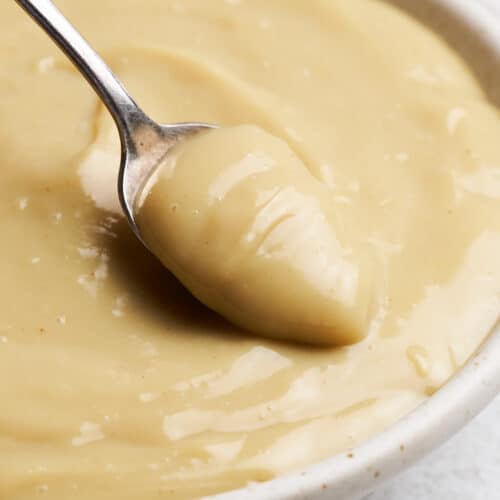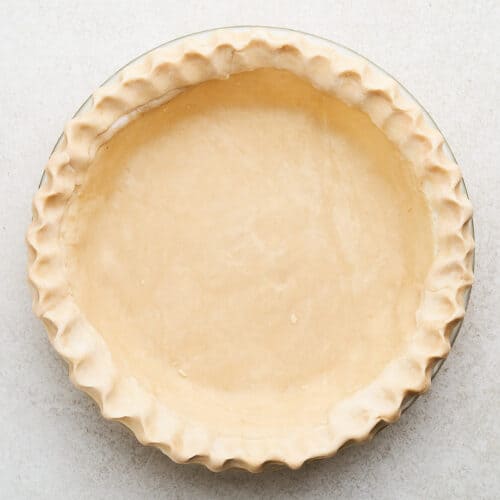Vegan Buttermilk
Making your own vegan buttermilk is simple and requires just 2 staple ingredients and 5 minutes of your time. Use it for all of your non-dairy baking needs, like pancakes, biscuits, and more!

This vegan buttermilk proves that plant-based alternatives are just as effective as their non-vegan counterparts! Using ingredients you likely already have, you can whip it up any time a recipe calls for buttermilk. For more dairy-free kitchen staples, check out my vegan heavy cream.
Why I love this recipe
Like my vegan condensed milk, this vegan buttermilk can be used in baking and cooking instead of regular buttermilk. Its acidity helps breads rise, especially when combined with baking soda. It also tenderizes gluten bonds, resulting in a delicious texture.
Everything is ready in 5 minutes and made with just soy milk and distilled white vinegar. Once combined, the mixture creates a tangy, creamy base perfect for baking, marinating, or breading.
This recipe is not only budget-friendly but also accessible to anyone with a measuring cup and spoon. If you need a dairy-free version of buttermilk, this recipe is a must-try!
Ingredient notes
With plant milk and an acid of your choosing, you’re well on your way to making your own vegan buttermilk. Find an ingredient breakdown and suitable substitutes below!

Soy milk
It’s best to choose plant milk with a high protein content. Soy milk is my go-to for its neutral flavor and ability to curdle, mimicking the texture of traditional buttermilk.
Substitute: The next best choices are pea milk, sesame milk, or oat milk.
Distilled white vinegar
I prefer using distilled white vinegar to curdle the milk. It’s the cheapest and most widely available acid with a neutral flavor.
Substitute: Lemon juice is more expensive compared to white vinegar, but it provides consistent results and is the most natural option. Apple cider vinegar also works. You can use all three interchangeably in equal amounts.
For a complete ingredient list and step-by-step guide, scroll down to the recipe card.
How to make
Learn the best way to make vegan buttermilk with my straightforward, easy-to-follow instructions. Look for the tips in green throughout this section for consistent and successful results!
Assembly
Step 1
Add 1 scant cup of room-temperature soy milk to a glass measuring cup or a small container. Pour 1 tablespoon of distilled white vinegar into the soy milk.
The reaction won’t happen if you’ve just removed your soy milk from the fridge. Let it warm to room temperature before adding the acid. If you are short on time, you can heat it in a saucepan until it reaches 160 degrees Fahrenheit.

Step 2
Stir the mixture gently to combine the vinegar and soy milk, then set it aside for 3-5 minutes to allow the soy milk to curdle. Use your vegan buttermilk in any recipe that calls for buttermilk, adjusting the quantity as needed.
Avoid over-stirring as it can disrupt the curdling process. A gentle stir is enough to mix the vinegar evenly through the milk.

Expert tip
If you have the option, opt for soy milk, which is the best candidate for vegan buttermilk. I’ve tested this recipe with every plant milk and soy always yields the best results.
With that in mind, don’t purchase milk that contains artificial flavors and sweeteners, as it may interfere with the cuddling process.
You also need to give the acid enough time to react with the protein and sugar in the milk. It should sit undisturbed for at least 5 minutes. Don’t skip this, or the buttermilk won’t curdle.
Recipe tips
Make it precise: If you’re using this vegan buttermilk for a precise baking recipe, remove exactly 1 tablespoon of plant milk from the recipe. Use the same amount of vinegar or lemon juice to yield 1 cup of buttermilk in total.
Follow the recipe: Since this recipe has been tested numerous times, I don’t recommend substitutions, as the results will vary.
Substitution proportions: When substituting vegan buttermilk in recipes, use it in a 1:1 ratio with regular buttermilk for the best results.

Frequently asked questions
If the recipe calls for vegan buttermilk, regular dairy-free milk will most likely not work. Buttermilk is an acid, so it reacts with other leavening agents like baking soda. This may result in a dense and tough baked good.
Almond milk should not be used for dairy-free buttermilk because it is low in protein. While 1 cup of soy milk contains 7-8 grams of protein, almond milk contains only 1 gram.
Yes, vegan buttermilk can be used as a 1:1 substitute in most recipes that call for traditional buttermilk. It offers a similar texture and acidity.
Storing
Vegan buttermilk is quick enough to make on an “as needed” basis.” But, if you find yourself with leftovers, it stores well too.
Fridge
Vegan buttermilk can be stored in the refrigerator. Pour it into a clean, airtight container, and it will keep well for up to 5 days. Glass jars are ideal for this purpose because they won’t retain odors and are easy to clean.
Freezer
Freezing is another option for extended storage periods. Freeze it in ice cube trays for easy portioning, then transfer the cubes to a freezer bag for up to 3 months. Thaw cubes in the refrigerator overnight before use.
More vegan basics
Hungry for more?
If you enjoyed this recipe, please consider leaving a star rating and a comment down below! Your feedback not only helps others discover our blog but also gives us valuable insights from your experience.
Don’t forget to subscribe to our newsletter for the latest recipes, and check out our shop for our top kitchen recommendations. Thank you for supporting BBV!
Recipe

Easy Vegan Buttermilk
Equipment
- Measuring cup
- Whisk or spoon
Ingredients
- 1 scant cup soy milk (room temperature)
- 1 tablespoon distilled white vinegar (lemon juice or apple cider vinegar)
Instructions
- Add soy milk and vinegar to a glass measuring cup or container.
- Stir to combine, then set aside for 3-5 minutes to let the soy milk curdle.
- Use your vegan buttermilk in any recipe that calls for buttermilk!
Notes
Nutrition
Note: I’ve updated this post to include new information and helpful tips about the recipe.
Justine Drosdovech is a food writer, photographer, and one of the founders of Broke Bank Vegan. She is a self-taught plant-based chef but uses her healthcare background to craft dishes that are both delicious and nourishing.




